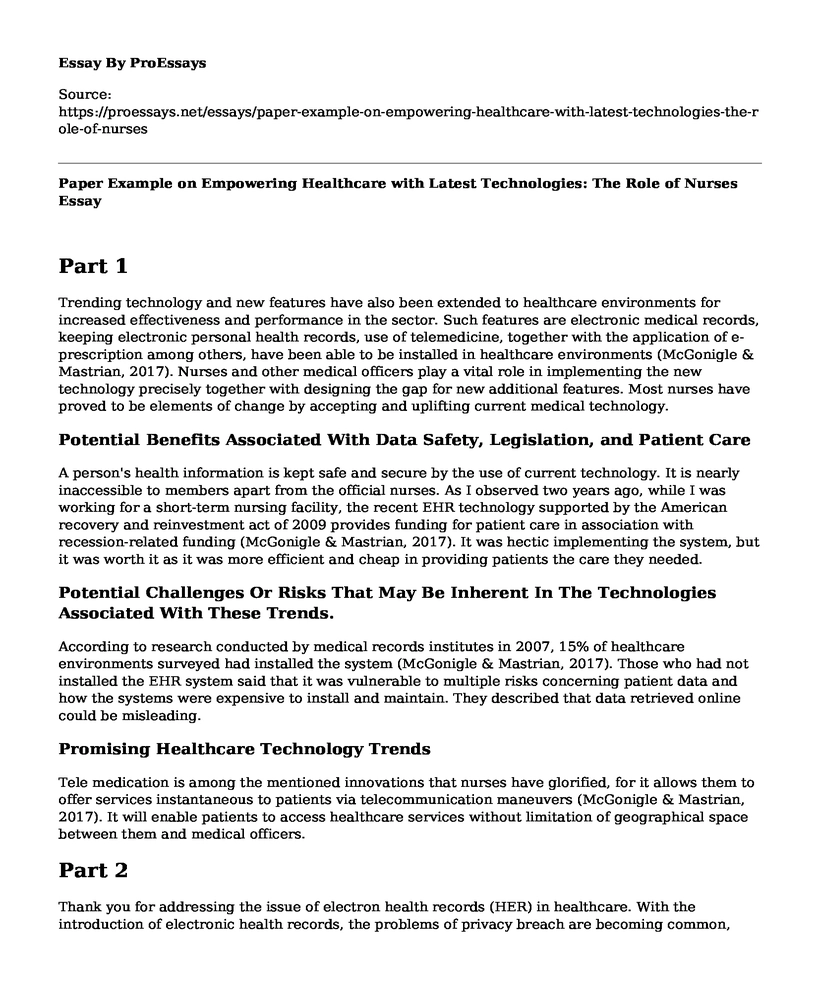Part 1
Trending technology and new features have also been extended to healthcare environments for increased effectiveness and performance in the sector. Such features are electronic medical records, keeping electronic personal health records, use of telemedicine, together with the application of e-prescription among others, have been able to be installed in healthcare environments (McGonigle & Mastrian, 2017). Nurses and other medical officers play a vital role in implementing the new technology precisely together with designing the gap for new additional features. Most nurses have proved to be elements of change by accepting and uplifting current medical technology.
Potential Benefits Associated With Data Safety, Legislation, and Patient Care
A person's health information is kept safe and secure by the use of current technology. It is nearly inaccessible to members apart from the official nurses. As I observed two years ago, while I was working for a short-term nursing facility, the recent EHR technology supported by the American recovery and reinvestment act of 2009 provides funding for patient care in association with recession-related funding (McGonigle & Mastrian, 2017). It was hectic implementing the system, but it was worth it as it was more efficient and cheap in providing patients the care they needed.
Potential Challenges Or Risks That May Be Inherent In The Technologies Associated With These Trends.
According to research conducted by medical records institutes in 2007, 15% of healthcare environments surveyed had installed the system (McGonigle & Mastrian, 2017). Those who had not installed the EHR system said that it was vulnerable to multiple risks concerning patient data and how the systems were expensive to install and maintain. They described that data retrieved online could be misleading.
Promising Healthcare Technology Trends
Tele medication is among the mentioned innovations that nurses have glorified, for it allows them to offer services instantaneous to patients via telecommunication maneuvers (McGonigle & Mastrian, 2017). It will enable patients to access healthcare services without limitation of geographical space between them and medical officers.
Part 2
Thank you for addressing the issue of electron health records (HER) in healthcare. With the introduction of electronic health records, the problems of privacy breach are becoming common, which compromise the need for personal data privacy. Increasing cyber-attacks are causing significant problems in keeping patient's data safe, lowering trust for customers. Attackers are increasingly targeting health services hence raising questions on the organization's safety as it tries to adapt to the growing technology trends (Laureate Education Executive Producer, 2018). Technology has resulted in the innovation of unique systems such as HIE, which allow easy sharing of information across the organization for the patients. The implication of such systems in healthcare is significant since general care conditions and healthcare quality has improved.
Technological and economic challenges have been faced in the past while implementing such systems within the healthcare organization. However, the current issue faced is integrating the system to meet health information and federal privacy laws. The impact of the Health Insurance Portability and Accountability Act (HIPPA), however, doesn't put penalties on patient health information sharing within the organization between the health professionals (Mello, Adlermilstein, Ding, & Savage, 2018). The HIPPA body does not also punish any resulting security breaches to personal privacy provided the set rules are met.
To deal with the challenges with electronic records in keeping healthcare information, other rules such as the Cures Acts are being formulated to cater to any mismatching and inaccurate patient information resulting from the use of electronic devices. Therefore, guidelines should be set to ensure all user data is secure to prevent information blocking by other competitive organizations and also cater to personal information within healthcare.
References
Laureate Education (Executive Producer). (2018). Electronic Records and Managing IT Change [Video file]. Baltimore, MD: Author.
McGonigle, D., & Mastrian, K. G. (2017). Nursing informatics and the foundation of knowledge (4th ed.). Burlington, MA: Jones & Bartlett Learning.
Mello, M. M., Adlermilstein, J., Ding, K. L., & Savage, L. (2018). Legal Barriers to the Growth of Health Information Exchange-Boulders or Pebbles?. The Milbank Quarterly, 96(1), 110-143.
Cite this page
Paper Example on Empowering Healthcare with Latest Technologies: The Role of Nurses. (2023, May 08). Retrieved from https://proessays.net/essays/paper-example-on-empowering-healthcare-with-latest-technologies-the-role-of-nurses
If you are the original author of this essay and no longer wish to have it published on the ProEssays website, please click below to request its removal:
- The Population at Risk of Developing Complications From Vascular Hemostasis Essay
- Hypothyroidism Condition Case Study Paper Example
- Essay on Cultural Empowerment of Children with Obesity
- High Prevalence of Kidney Stones in Asian Jews: Essay Sample
- Conflict Management in Nursing: Strategies for Leaders - Essay Sample
- Essay on Domestic Violence and Women With Learning Disabilities: An In-Depth Exploration
- Essay Sample on ANA: A Lifeline for Nurses & Healthcare Providers Dealing with Ethical Dilemmas







